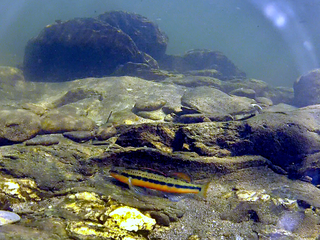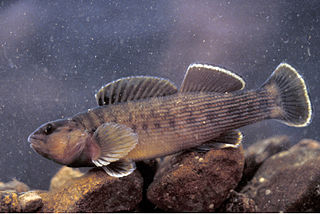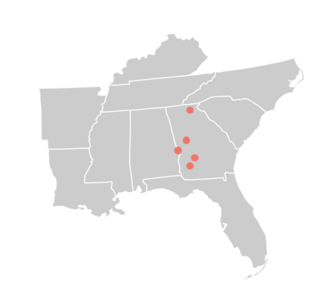
The leopard darter is a species of freshwater ray-finned fish, a darter from the subfamily Etheostomatinae, part of the family Percidae, which also contains the perches, ruffes and pikeperches. It is native to the United States, where it can be found only in the Little River drainage in Oklahoma and Arkansas. Its typical habitat is medium to large streams with rubble and boulder substrate. It feeds on small invertebrates on the riverbed and spawns mainly in March and April. It is threatened by impoundment, habitat loss and runoff from agricultural activities. It has never been a common species and has been listed as a threatened species in the United States since 1978, and the International Union for Conservation of Nature lists it as a "vulnerable species".

The amber darter is a small, endangered species of freshwater ray-finned fish, a darter from the subfamily Etheostomatinae, part of the family Percidae, which also contains the perches, ruffes and pikeperches. It is native to the Conasauga River and Etowah River in Georgia and Tennessee in the United States. It typically inhabits riffle areas over gravel and sand bottoms, hiding in aquatic vegetation when present. It feeds on small invertebrates and probably breeds between late fall and early spring. It is an uncommon fish with a small range and the International Union for Conservation of Nature has classified its conservation status as being "endangered".

The tangerine darter or river slick is a small species of freshwater ray-finned fish, a darter from the subfamily Etheostomatinae, part of the family Percidae, which also contains the perches, ruffes and pikeperches. It is found in the eastern United States. It grows to a length of 4.3 to 7.1 inches, males being bright orange-red while females are yellow. It is insectivorous, picking insect larvae off aquatic plants and the riverbed, and sometimes rolling small stones over to expose prey. It breeds in late spring and early summer, typically in shallow sandy or gravelly riffles. Pollution and habitat degradation may be a problem in parts of its range, however it is a fairly common fish with a wide range and the International Union for Conservation of Nature has classified its conservation status as being of "least concern".

The Roanoke logperch is a species of freshwater ray-finned fish, a darter from the subfamily Etheostomatinae, part of the family Percidae, which also contains the perches, ruffes and pikeperches. It is found in the Roanoke and Chowan drainages in Virginia and North Carolina in the United States. It inhabits low and moderate-gradient streams and rivers in warm, clear water in mostly unsilted gravel and rubble in runs, pools, and riffles. It is primarily insectivorous. This fish is a federally listed endangered species.

The Conasauga logperch is a species of freshwater ray-finned fish, a darter from the subfamily Etheostomatinae, part of the family Percidae, which also contains the perches, ruffes and pikeperches. It is endemic to the United States. It is one of 184 species of darters in North America. It has been listed as endangered throughout its range with critical habitat under the U.S. Endangered Species Act since August 5, 1985.
The longnose darter is a species of freshwater ray-finned fish, a darter from the subfamily Etheostomatinae, part of the family Percidae, which also contains the perches, ruffes and pikeperches. It is endemic to the United States.

The channel darter is a species of freshwater ray-finned fish, a darter from the subfamily Etheostomatinae, part of the family Percidae, which also contains the perches, ruffes and pikeperches. It is native to North America where it typically occurs in the sandy or gravelly shallows of lakes and in small and medium-sized rivers in riffles over sand, gravel or rock bottoms. It is a small fish ranging from 34 to 72 mm in length, olive brown with darker speckles and sometimes with a dark spot below the eye and dark blotches along the flank. It feeds mostly on insect larvae and other small invertebrates and breeds in small streams. This species is listed as threatened by the Canadian Species at Risk Act (SARA) but overall it has a wide range and numerous sub-populations and the International Union for Conservation of Nature has rated it as a "least concern species".

The bluebreast darter is a small species of freshwater ray-finned fish, a darter from the subfamily Etheostomatinae, part of the family Percidae, which also contains the perches, ruffes and pikeperches. It is endemic to the eastern United States from New York and Illinois to Tennessee and North Carolina.

The snubnose darter is a species of freshwater ray-finned fish, a darter from the subfamily Etheostomatinae, part of the family Percidae, which also contains the perches, ruffes and pikeperches. It is endemic to the southeastern United States.

The gulf darter is a species of freshwater ray-finned fish, a darter from the subfamily Etheostomatinae, part of the family Percidae, which also contains the perches, ruffes and pikeperches. It is found in Louisiana, Mississippi, Alabama, Florida, Tennessee, and Kentucky. It is a colorful fish, males having vertical barring of red-orange and blue-green near the tail, growing to a length of about 7.8 centimeters (3.1 in). It is typically found in small and medium-sized creeks, often in very shallow water. It occurs over sandy bottoms and among aquatic vegetation such as Sparganium americanum, foraging among the plants and organic debris for insect larvae and small invertebrates. The International Union for Conservation of Nature has assessed its conservation status as being of "least concern".

The gilt darter is a species of freshwater ray-finned fish, a darter from the subfamily Etheostomatinae, part of the family Percidae, which also contains the perches, ruffes and pikeperches. It can be found in a number of states in the Mississippi River drainage of the United States although it has been extirpated from some river systems in which it was at one time present, mostly due to siltation and pollution problems. Males are more colorful than females and can grow to a length of about 9 cm (3.5 in). It is a benthic fish that feeds primarily on small aquatic insect larvae. Males form territories during the breeding season in late spring and early summer. Spawning typically takes place at the upper ends of riffles with sandy and gravelly bottoms interspersed with larger cobbles. Some organisations are endeavouring to conserve populations of the gilt darter and re-introduce it to states where the fish has been extirpated but suitable habitat still exists.

Percina maculata, the blackside darter, is a species of freshwater ray-finned fish, a darter from the subfamily Etheostomatinae, part of the family Percidae, which also contains the perches, ruffes and pikeperches. It is a widespread inhabitant of streams and rivers in the Mississippi River watershed. Like other darters it prefers rocky riffles and sandy runs, but is tolerant of pools and still water as well. It is one of the 324 fish species found in Tennessee.
Percina phoxocephala, the slenderhead darter, is a species of freshwater ray-finned fish, a darter from the subfamily Etheostomatinae, part of the family Percidae, which also contains the perches, ruffes and pikeperches. It is found in North America in the central Ohio and Mississippi River basins, to northeastern South Dakota and the Lake Winnebago system in Wisconsin, and as far south as the Red River in eastern Oklahoma and northeast Texas, typically in small to medium size rivers. It is a colorful species, with an average length of 6 to 9 centimeters. Males take on a deeper hue during the breeding season. It feeds on insect larvae and other small invertebrates, and spawns between April and June. It is a common fish with a very wide range and the International Union for Conservation of Nature has classified its conservation status as being of "least concern".
Percina shumardi is a benthic species of freshwater ray-finned fish, a darter from the subfamily Etheostomatinae, part of the family Percidae, which also contains the perches, ruffes and pikeperches. It is native to North America. It is an inhabitant of small and medium rivers where it occurs in rocky riffles with clear, fast-flowing water. The river darter can reach up to 7.3 cm in length and has an average lifespan of three years. It can be distinguished from other darters by its unique front and rear spots on the dorsal fin.

Etheostoma variatum, the variegate darter, is a species of freshwater ray-finned fish, a darter from the subfamily Etheostomatinae, part of the family Percidae, which also contains the perches, ruffes and pikeperches. It is native to the eastern United States where it occurs primarily in the Ohio River basin; it is present in the states of Ohio, New York, Pennsylvania, Indiana, West Virginia and Kentucky with a small population in Virginia. It is a large darter, growing to 10 cm (4 in) long, orange-red with black vertical barring on its body, and horizontal barring on its front dorsal fin. Its typical habitat is swift-flowing riffles with rubble, boulder and gravel. No major threats have been identified for this fish and the International Union for Conservation of Nature has assessed its conservation status as being of "least concern".
The bigmouth chub is a species of fish native to West Virginia.

The redfin darter is a species of freshwater ray-finned fish, a darter from the subfamily Etheostomatinae, part of the family Percidae, which also contains the perches, ruffes and pikeperches. It is native to the south-central United States, where it occurs in Missouri, Arkansas, Kansas, and eastern Oklahoma.

The Chesapeake logperch is a small species of freshwater ray-finned fish, a darter from the subfamily Etheostomatinae, part of the family Percidae, which also contains the perches, ruffes and pikeperches. It is found in the Chesapeake Bay drainages. It prefers gravel runs and riffles of small to medium-sized rivers.

The Halloween darter is a small freshwater fish native to North America. It is found in Georgia and Alabama in the drainage basin of the Apalachicola River, specifically in the Flint River system and the Chattahoochee River system. It prefers shallow, fast-flowing areas with gravel bottoms in small and medium-sized rivers. It was first described in 2008, having not previously been distinguished from the Blackbanded darter (P. nigrofasciata), formerly though to occur in the same watershed. Blackbanded darter has since been split again with Westfall's darter now recognised from the Apalachicola drainage. The species is somewhat variable, being generally blackish dorsally, with some individuals having indistinct saddle-like barring. Males have orange and dark lateral striping while females have dark stripes and a yellowish-green belly. At a maximum standard length of 101 mm (4 in), males are slightly larger than females, and both sexes develop distinctive orange barring on the edge of the first dorsal fin during the breeding season.
The chainback darter is a species of freshwater ray-finned fish, a darter from the subfamily Etheostomatinae, part of the family Percidae, which also contains the perches, ruffes and pikeperches. It is found in North America where it occurs in the Roanoke-Chowan river drainage in Virginia south to the Neuse River drainage in North Carolina. It prefers gravel runs and riffles of small to medium-sized rivers.
















